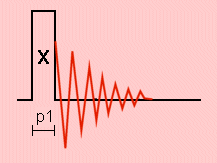References for one-pulse nutation NMR

The one-pulse sequence is the simplest NMR experiment. The corresponding one-dimensional nutation method allows us to determine, from a featureless NMR lineshape, the quadrupole coupling in a single crystal or the quadrupole coupling constant in a powder sample.
References containing data and graphs that can be simulated with the one-pulse applets are provided:
-
T. Azaïs, C. Bonhomme, L. Bonhomme-Coury, J. Vaissermann,
Y. Millot, P. P. Man, P. Bertani, J. Hirschinger, and J. Livage
Cubane shaped clusters, precursors for aluminophosphate frameworks: a solid state multinuclear NMR study, in time and frequency domains (PDF article, 337 Kb),
J. Chem. Soc., Dalton Trans. 609-618 (2002). -
P. P. Man
Quadrupole couplings in nuclear magnetic resonance, general (PDF article, 720 Kb),
in "Encyclopedia of analytical chemistry", edited by R. A. Meyers (J. Wiley, Chichester, 12224-12265, 2000). -
M. E. Smith and E. R. H. van Eck
Recent advances in experimental solid state NMR methodology for half-integer spin quadrupolar nuclei,
Progr. NMR Spectrosc. 34, 159-201 (1999). -
H. W. Shin, S. H. Choh, T. H. Yeom, K. S. Hong, and D. Y. Han
1D nutation NMR of 7Li in LiTaO3 and LiNbO3 single crystals and powders,
J. Korean Phys. Soc. 32, S662-S664 (1998). -
A. P. M. Kentgens
A practical guide to solid-state NMR of half-integer quadrupolar nuclei with some applications to disordered systems,
Geoderma 80, 271-306 (1997). -
P. P. Man, S. H. Choh, and J. Fraissard
Application of 1D nutation NMR to 51V in ferroelastic BiVO4,
Solid State Nucl. Magn. Reson. 3, 231-236 (1994). -
P. P. Man and P. Tougne
Exact expression for the spin-7/2 line intensities: application to solid state 59Co(III) NMR (PDF article, 499 Kb),
Mol. Phys. 83, 997-1009 (1994). -
M. A. Hepp, P. P. Man, A. Trokiner, and J. Fraissard
Determination of the quadrupole coupling from featureless line shapes,
Magn. Reson. Chem. 32, 24-28 (1994). -
P. P. Man
Excitation conditions for quantitative determination of quadrupolar spins with one-pulse and spin-echo sequences in solid-state NMR,
Appl. Magn. Reson. 4, 65-87 (1993). -
P. P. Man
Analytical expression for the spin-5/2 line intensities,
Mol. Phys. 78, 307-318 (1993). -
D. Freude and J. Haase
Quadrupole effects in solid-state nuclear magnetic resonance,
in "NMR Basic Principles and Progress", vol. 29, 1-90 (1993). -
M. A. Hepp, P. P. Man, A. Trokiner, H. Zanni, and J. Fraissard
Determination of the electric field gradient in RbCaF3 near the phase transition (PDF article, 397 Kb),
Solid State Commun. 84, 869-873 (1992). -
P. P. Man
Measurement of quadrupolar spin population by solid-state NMR (PDF article, 349 Kb),
J. Magn. Reson. 77, 148-154 (1988). -
P. P. Man
Investigation of the central line of 55Mn in KMnO4 by a two-dimensional NMR method (PDF article, 664 Kb),
J. Magn. Reson. 67, 78-90 (1986). -
D. Fenzke, D. Freude, T. Frolich, and J. Haase
NMR line intensity measurements of half-integer quadrupole nuclei,
Chem. Phys. Lett. 111, 171-175 (1984). -
A. Samoson and E. Lippmaa
Excitation phenomena and line intensities in high-resolution NMR powder spectra of half-integer quadrupolar nuclei,
Phys. Rev. B 28, 6567-6570 (1983).
SIMPSON scripts and Mathematica-5 notebooks
Use Wolfram CDF Player to read Mathematica notebook in modern web browser.
- Effet of offset on one pulse 90°(X)-detection applied to positive gyromagnetic ratio nucleus:
*magnetization x component,
*magnetization y component,
*magnetization z component,
*corresponding Mathematica 5 notebook. - Effet of offset on one pulse 90°(-X)-detection applied to positive gyromagnetic ratio nucleus:
*magnetization x component,
*magnetization y component,
*magnetization z component,
*corresponding Mathematica 5 notebook. - Effet of offset on one pulse 90°(Y)-detection applied to positive gyromagnetic ratio nucleus:
*magnetization x component,
*magnetization y component,
*magnetization z component,
*corresponding Mathematica 5 notebook. - Composite rotation matrices in Mathematica-5 notebook:
*passive rotation about rotated coordinate axes,
*active rotation about rotated coordinate axes.
